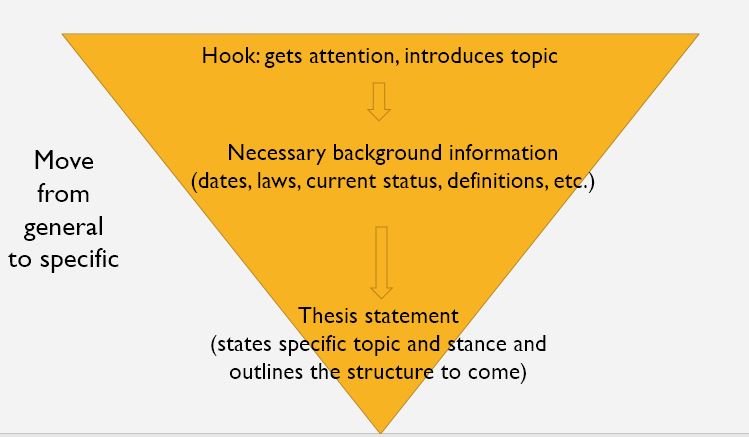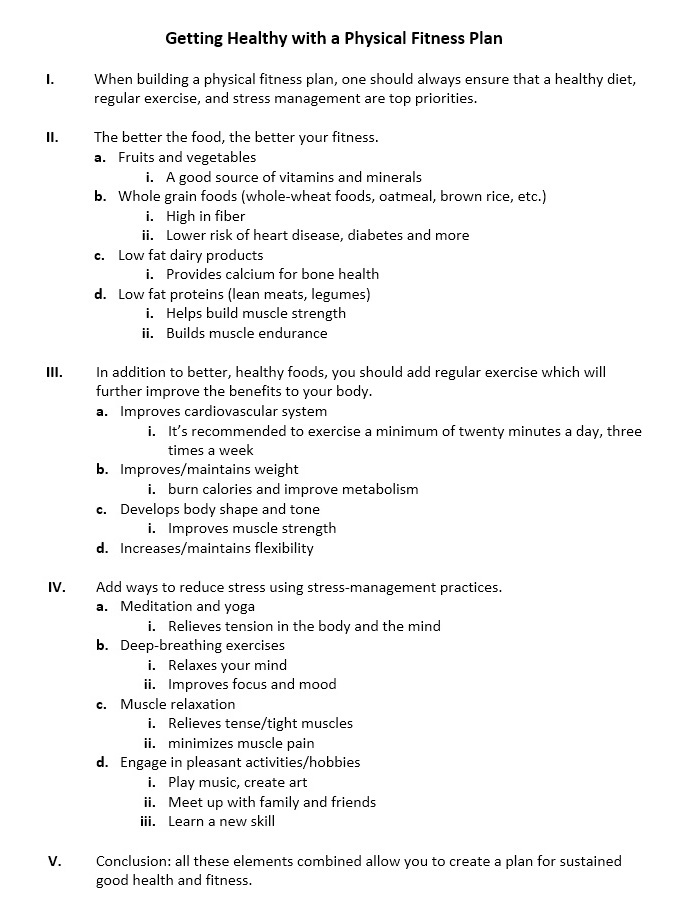13 Writing the Thesis and Outline
Learning Objectives
After completing the activities in this chapter, you will be able to:
- Identify three ways to organize your ideas
- Identify the components of a thesis statement
- Evaluate thesis statements
- Identify the steps needed to create an outline
- Create a thesis statement and outline
To write well, you need to understand your audience and purpose. Once you know why you are writing, and to whom, you can start to organize your ideas. One way to get organized is to create an outline before you begin to write. An outline is the blueprint to your finished product.
Research Question
It’s a good idea to start a writing project with a research question. If your instructor has provided you with a broad topic, creating a research question might help you narrow that topic down:
| Broad Topic | Research Question |
| Health | How can someone get healthy? |
| Exercise | What are the benefits of exercise? |
| Culture shock | How can culture shock negatively affect international students? |
| Minimum wage | Should the government increase minimum wage? |
| Diversity in the workplace | What are the challenges and benefits of having a diverse workforce? |
Now you need to do research to determine your answer to the question. Doing some preliminary research will give you a broad understanding of your narrowed topic, which will help you decide your stance and determine how you can support your stance.
Creating a Thesis Statement
You can write a draft thesis statement after you’ve done some preliminary research. You need to do this research first to ensure that you can answer your research question using credible sources. See the Researching chapter of this book for more details.
Your thesis statement is a concise one-sentence answer to your research question.
The thesis statement expresses three things:
- the specific topic of the paper
- your stance (or, “opinion” or “position”) on that topic
- the main reasons for your opinion
The table below shows how a thesis statement evolves from a broad topic.
| Broad Topic | Research Question | Thesis Statement |
| Health | How can someone get healthy? | To look and feel good, people need a healthy diet, regular exercise, and good stress management. |
| Exercise | What are the benefits of exercise? | Exercise helps people maintain healthy bodies and handle mental pressure. |
| Culture Shock | How can culture shock affect international students? | Culture shock can negatively affect international students emotionally, physically, and academically. |
| Minimum Wage | Should the government increase the minimum wage? | The minimum wage in Canada should be increased to increase the physical, social, and financial well-being of workers. |
| Diversity in the workforce | What are the challenges and benefits of having a diverse workforce? | When workforces are diverse, managers may require training to realize gains in innovation and customer satisfaction. |
Can you identify the three necessary components in each of the thesis statements above? Notice that all of the thesis statements above are for papers that will have three body paragraphs; which one thesis is for an essay that will have only two body paragraphs?
Learning Check
Check your understanding of thesis statements. Consider this example thesis statement and answer the questions below:
Culture shock can negatively affect international students emotionally, physically, and academically.
Parallel Structure in Thesis Statements
Notice that the supporting reasons in each thesis above are given in parallel structure.
Thesis Statement Placement
Your thesis is the single most important sentence in your writing. In academic writing, the thesis statement is placed at the end of the introductory paragraph.

You will make several attempts before you devise a working thesis statement that you think is effective. Each draft of the thesis statement will bring you closer to the wording that expresses your meaning exactly.
Outlines
Information in this section has been adapted from Chapter 8.2: Outlining in Writing for Success by University of Minnesota Libraries[1] which is made available by Pressbooks under a CC BY-NC-SA license except where otherwise noted.
For an essay question on a test or a brief oral presentation in class, all you may need to prepare is a short, informal outline in which you jot down key ideas in the order you will present them. This kind of outline reminds you to stay focused in a stressful situation and to include all the good ideas that help you explain or prove your point.
For a longer assignment, like an essay or a research paper, many college instructors require students to submit their outline for approval before writing and submitting the paper for grading. This is a way to be sure you are on the right track and are working in an organized manner.
A formal outline is a detailed guide that shows how all your supporting ideas relate to each other. It helps you distinguish between ideas that are of equal importance and ones that are of lesser importance. You build your paper based on the framework created by the outline. Instructors may also require you to submit an outline with your final draft to check the direction of the assignment and the logic of your final draft. If you must submit an outline with the final draft of a paper, remember to revise the outline to reflect any changes you made while writing the paper.
Here’s an example of a detailed outline for a standard 5-paragraph essay[2]:

Notice that there are three body paragraphs (II, III, and IV). Each body paragraph contains four main ideas (a-d) and each main idea is further supported with a few specific details (i-iii). In a research essay, those specific details should be facts from reliable sources and there should be an APA in-text citation (Author, year, location) next to each one.
Organizing Ideas
The three common methods of organizing writing are chronological, spatial, and importance.
| Chronological order |
|
| Spatial Order |
|
| Order of Importance |
|
As you create your outline, be mindful of how you organize your supporting body paragraphs. In the example outline above, the writer has chosen to present ideas in “order of importance” with the last, and most persuasive, reason last. Putting the most important reason at the end is an effective strategy for persuasive writing.
Checklist: Writing an Effective Outline
- Do I have a controlling idea that guides the development of the entire piece of writing?
- Do I have three or more main points that I want to make in this piece of writing? Does each main point connect to my controlling idea?
- Is my outline in the best order—chronological order, spatial order, or order of importance—for me to present my main points? Will this order help me get my main point across?
- Do I have supporting details that will help me inform, explain, or prove my main points?
- Do I need to add more support? If so, where?
- Do I need to make any adjustments in my working thesis statement before I consider it the final version?
- University of Minnesota Libraries. (2015). Writing for success. Pressbooks. https://open.lib.umn.edu/writingforsuccess/ ↵
- Veillieux, H. (2021, April 9). 5 Paragraph Outline Example [Digital Image]. In Writing the thesis and outline. Confederation College. https://bit.ly/36aiBWn. CC BY 4.0. ↵
a writer's position, or opinion, on their topic
Supporting points are the main reasons that explain your point of view on a topic. In a research paper, support should be facts and opinion of experts that you have located from reliable sources. In reflective writing, support might include your personal experiences.
In grammar, parallelism, also known as parallel structure or parallel construction, is a balance within one or more sentences of similar phrases or clauses that have the same grammatical structure. The application of parallelism affects readability and may make texts easier to process.
Provide an in-text citation (with author and date information) along with a reference entry (containing complete retrieval information) to tell the reader the original source of the information used.

